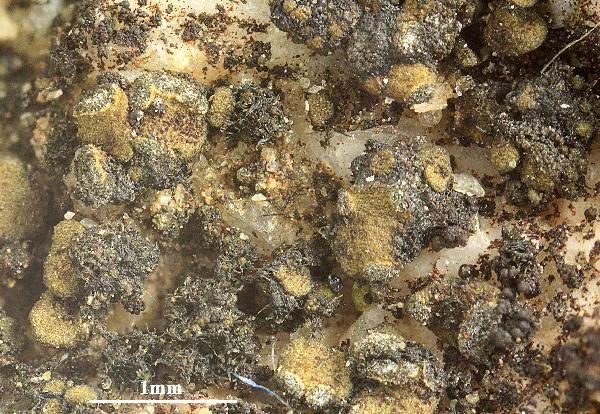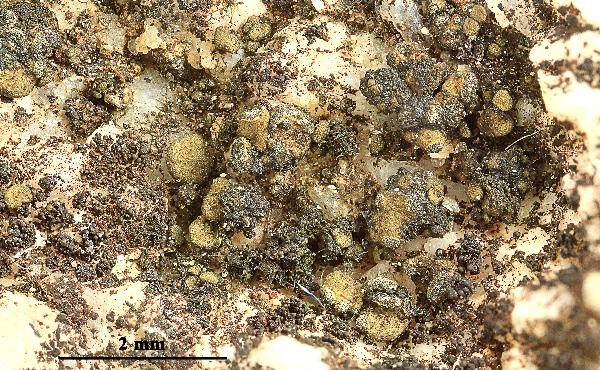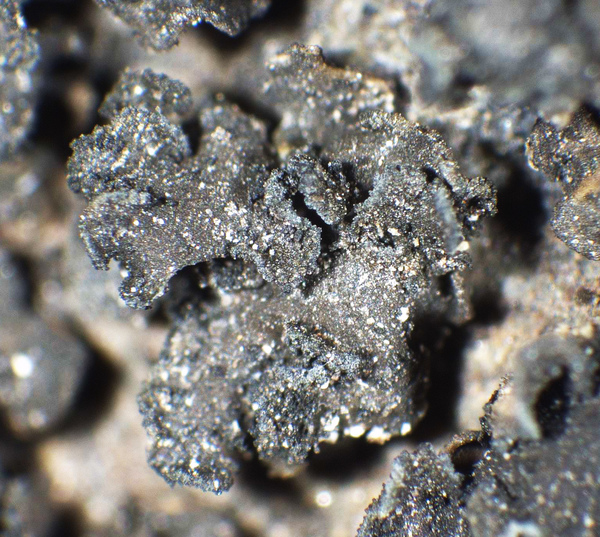Peltula bolanderi (Tuck.) Wetmore
Ann. Missouri Bot. Gard., 57, 2: 179, 1971 (1970). Basionym: Pannaria bolanderi Tuck. - Gen. Lich.: 51, 1872.
Synonyms:
Distribution:
Description: Thallus squamulose-peltate, the individual squamules scattered or in irregular patches, 1-2(-3) mm wide, minutely lobulate, with often strongly undulated margins bearing orbicular to linear soralia with farinose, black soredia. Upper surface dark olive green to olive brown, lower surface paler, attached by a central holdfast. Upper cortex substituted by a yellow to brownish, up to 10 µm thick epinecral layer; photobiont layer poorly delimited from the medulla, which is composed of loosely interwoven hyphae with elongated or globose cells; lower cortex 20-75 µm thick, pseudoparenchymatous, with globose, 7-8 µm wide cells. Apothecia rare, adnate, with a raised rim at maturity. Proper exciple thin; epithecium pale yellow, K-; hymenium colourless, I+ wine-red, 150-170 µm high; paraphyses thin, sometimes anastomosing, rarely branched, the apical cells slightly swollen; hypothecium colourless. Asci >100-spored, clavate to obclavate, unitunicate-rostrate with a distinct, fringed external tunica, the walls I+ red, K/I+ intensely blue. Ascospores 1-celled, hyaline, globose to ellipsoid, 5-7.6 x 3-4.5 µm. Pycnidia globose, up to 150 µm across. Conidia simple, fusiform, 3.1-3.7 x 1.2 µm. Photobiont cyanobacterial, , chroococcoid, one-celled. Spot tests: K-, C-, KC-, P-, UV-. Chemistry: without lichen substances.Note: a species of base-rich siliceous rocks with periodical percolarion of water, widespread in arid and semi-arid areas of both Hemispheres, and also known from Portugal and Spain (Márquez & al. 2013). To be looked for in the driest sites of Mediterranean Italy, especially in Sardinia.
Growth form: Squamulose
Substrata: rocks
Photobiont: cyanobacteria, coccaceous (e.g. Gloeocapsa)
Reproductive strategy: mainly asexual, by soredia, or soredia-like structures (e.g. blastidia)
On otherwise dry surfaces with short periods of water seepage after rain

Predictive model


Felix Schumm - CC BY-SA 4.0
[ABL27937], Brazil, Santa Catarina, São Francisco do Sul, S of Prainha.
26°14'06'' S, 48°30'05'' W, 10 m. On coastal granite. Leg. M.
Cáceres & A. Aptroot (no 27937), 8 October 2015, det. A. Aptroot
2015.
Growth form: Squamulose
Substrata: rocks
Photobiont: cyanobacteria, coccaceous (e.g. Gloeocapsa)
Reproductive strategy: mainly asexual, by soredia, or soredia-like structures (e.g. blastidia)
On otherwise dry surfaces with short periods of water seepage after rain

Predictive model





